Have you ever heard about the giant spiders that inhabit Texas? If not, then you’re certainly in for a surprise! Texas is home to a wide range of spiders that come in all shapes and sizes, ranging from small and harmless to large and imposing.
From the colorful desert spider to its more venomous relatives such as Wolf Spiders and Tarantulas, these remarkable creatures offer an amazing opportunity for learning and exploration.
In this blog post, we will take a look at the top 8 giant arachnids of Texas complete with vivid images so that you don’t miss out on anything, and know how to identify them.
8 Large Spiders Found In Texas
1. Texas Brown Tarantula
First on the list is the Texas Brown Tarantula, scientifically known as Aphonopelma hentzi. This species is definitely one of the largest spiders found in Texas, and indeed, in North America.
The average body length of a fully grown Texas Brown Tarantula can go up to 3 inches, with a leg span reaching up to 4 inches or more. Their body is usually brown, which gives them their name and also helps them blend in with their landscape.
Males, though slightly smaller in build than females, still possess a formidable stature compared to other spider species.
These tarantulas inhabit the southern United States, particularly Texas, and also populate other states like Kansas, Missouri, Louisiana, Arkansas, Oklahoma, and New Mexico.
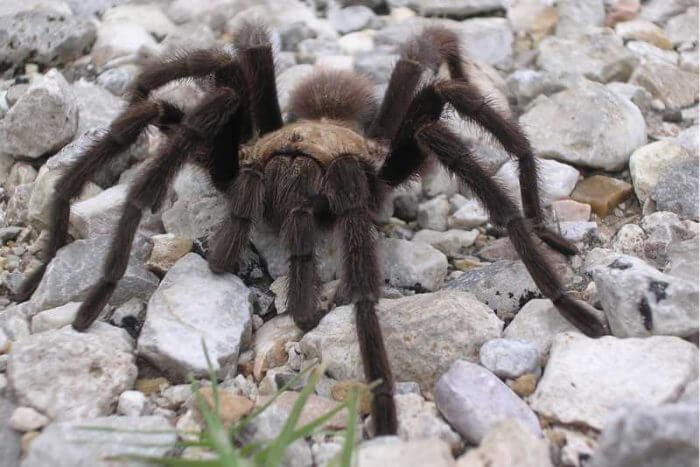
They prefer to live in dry, open areas, making their homes in deep burrows that they either dig themselves or take over from other animals. These burrows serve as protection from predators and harsh weather conditions.
When it comes to their diet the Texas Brown Tarantulas are carnivorous, feeding primarily on insects. However, due to their large size, they are also capable of hunting small lizards, snakes, and even small birds.
They rely on ambush tactics to capture their prey, waiting patiently in their burrows until a potential meal wanders too close. Despite their intimidating appearance and hunting prowess, Texas Brown Tarantulas are generally docile creatures. They would rather flee than fight when threatened by humans.
Characteristics
- They have a hairy body and hairy legs
- Their color is typically brown, black, gray, and orange
Habitat
- Typically found in grasslands, burrowed underground
- They may also use logs, stone walls, or abandoned dens as their home
2. Carolina Wolf Spider
Scientifically known as Hogna Carolinensis, the Carolina Wolf Spider notably stands out as one of the largest spiders found in Texas. This arachnid holds the title of being the biggest among the wolf spider species in North America.
Its impressive size, with males reaching 18-20mm and females 22-35mm in body length, not counting their long, robust legs, easily sets it apart from other species. The Carolina Wolf Spider’s striking appearance features a mottled brown coloration that provides excellent camouflage.
The males typically have a slight orange colour on their sides which is a good way to identify their gender.
When it comes to the females, they often carry their egg sacs during incubation! At times this egg sac may appear blue from a distance and is located at the rear of the spider.
These spiders are also nocturnal hunters, often venturing out at night to stalk their prey.
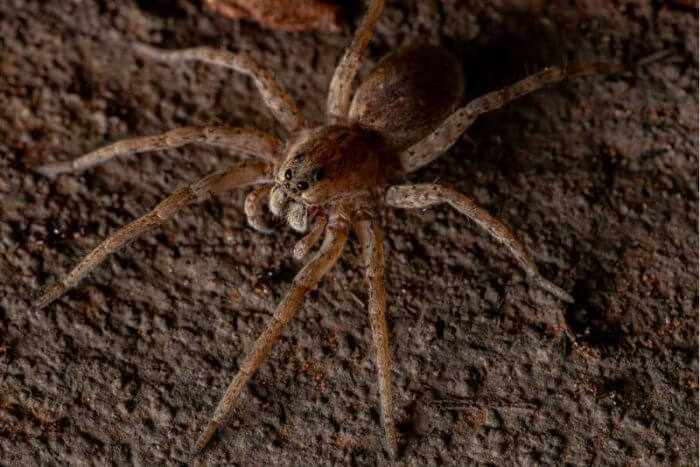
Their powerful vision, unique among spiders, contributes significantly to their hunting success. They don’t build webs to catch prey, instead, they actively seek out and run down their quarry.
The Carolina Wolf Spider’s size, hunting strategies, and intriguing behaviors are what make it a compelling species and a significant part of Texas’s arachnid fauna.
Characteristics
- Light and dark brown patterning
- Males have orange on their side
- Eight eyes in three rows
- Largemouth appendages
- Green eyes shine in their eyes
- Long robust legs
Habitat
- Open flat areas
- Desert scrub to woodland areas
- Nests in tiny crevices, rocks, or walls
3. Arizona Blond Tarantula
Step into the world of the Arizona Blond Tarantula, also known as the “Mexican blonde tarantula” a true spectacle among Texas’s spider population. This beast of a spider is undeniably one of the largest you’ll encounter in Texas.
Females can grow up to an imposing 3 to 4 inches in body length, and when you factor in their long, hairy legs, they’re a sight that commands attention.
But size isn’t the only thing that makes this tarantula stand out. The Arizona Blond Tarantula, named for its distinctive coloration, sports a stunning combination of dark and light hues.
Fine, golden hairs adorn a body of rich chocolate or gray, giving it a unique ‘blond’ appearance that’s hard to miss.
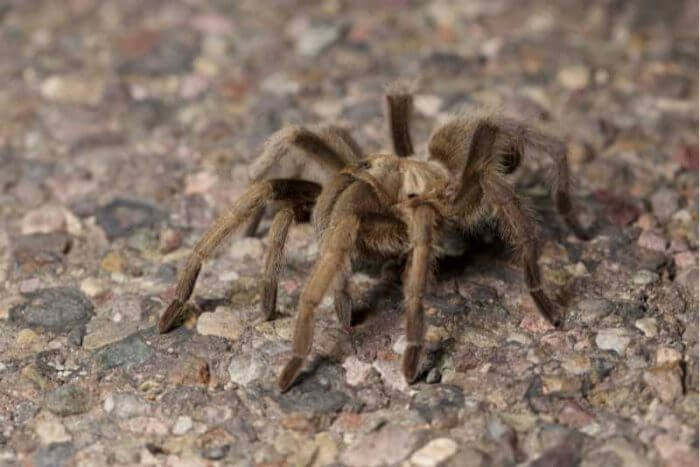
What’s more, these tarantulas lead a fascinating lifestyle. They’re not your typical web weavers, they’re burrowers. They carve out homes on the earth, using these tunnels as safe hideouts and strategic points for ambushing their prey. It’s a marvel of nature’s ingenuity!
And let’s not forget about their extraordinary lifespan. While most spiders live for just a few years, the female Arizona Blond Tarantula can live for up to 30 years. That’s ten times longer than most of their arachnid cousins! which is why these tarantulas are very popular pets for beginners.
In short, the Arizona Blond Tarantula is more than just a large spider. It’s a testament to nature’s diversity, a captivating creature that adds its own unique flavor to the rich tapestry of Texas’s wildlife.
Characteristics
- Females have a uniform tan color
- Males have black legs, a copper-colored cephalothorax, and a reddish abdomen
Habitat
- Typically seen in the southwestern deserts
- Prefers to be out in the summer rainy seasons
4. Huntsman Spider
The Huntsman Spider, also known as the “giant crab spider” stands out as another notable member of the Texas spider community. These spiders are certainly recognized for their size, with some species boasting a leg span that can reach up to 12 inches.
It’s this impressive size, combined with their distinctive crab-like stance, that makes encountering a Huntsman Spider an unforgettable experience. Yet, it’s not just their size that sets them apart.
Huntsman Spiders are gifted with remarkable speed and agility. They’re not web weavers; they’re active hunters, dashing across surfaces at high speeds to catch their unsuspecting prey.
Watching a Huntsman Spider in action is like watching a well-choreographed dance; it’s a thrilling display of nature’s predatory prowess.
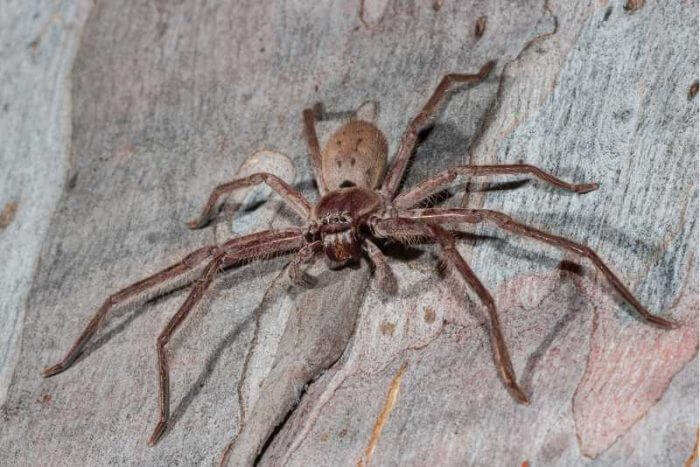
Their coloration adds another layer to their charm. Typically brown or gray, these spiders blend seamlessly into their surroundings, making them masterful camouflagers.
They’re often found lurking on tree trunks, beneath rocks, or even in the nooks and crannies of homes, always ready to dash out at a moment’s notice.
In terms of behavior, Huntsman Spiders are known to be relatively non-aggressive towards humans. While their size might seem intimidating, they generally prefer to flee rather than fight when confronted.
From their striking size to their rapid hunting techniques and their fascinating behaviors, the Huntsman Spider is undoubtedly a standout character in Texas’s diverse spider landscape.
It’s a creature that commands respect and admiration, reminding us of the captivating world of arachnids that exists right under our noses.
Characteristics
- Laterigrade legs, similar to those of crabs
- Reddish patches over their mouth
- The body is grey & brown with striped bands on its legs
Habitat
- Prefers infrequently, disturbed places
- Nests under rocks, woodpiles, sheds
5. Trap Door Spider
Next on this list is the Trap Door Spider, an intriguing giant hidden beneath the soils of Texas. This arachnid, belonging to the family Ctenizidae, is known for its unique lifestyle and captivating hunting strategy. The Females are 0.39-1.5 in (1-4 cm), with the males being slightly smaller.
Instead of weaving a web or actively stalking its prey, it builds a burrow with a silk-lined door, hence the name ‘Trap Door’. The spider waits patiently behind this hinged door, springing into action when an unsuspecting insect ventures too close.
The appearance of Trap Door Spiders is also equally captivating. They’re often brown in color, allowing them to blend seamlessly with the soil of their burrows.
Their bodies are very robust, designed for life underground, and they have a wide geographical area with different species found across the globe.
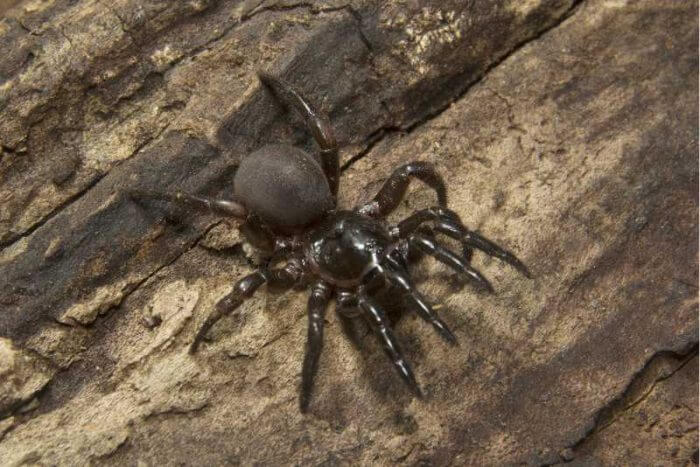
In the United States, they’re particularly prevalent in warmer regions, including parts of Texas. However, it’s worth noting that despite their somewhat fearsome hunting technique, Trap Door Spiders pose little threat to humans.
Their venom is not harmful to us, and they generally prefer to stay hidden in their burrows rather than interact with the larger world outside.
In a nutshell, the Trap Door Spider is a testament to nature’s ingenuity. From its unique hunting method to its earth-toned camouflage and preference for a subterranean lifestyle, it offers a fascinating glimpse into the diverse world of spiders.
Characteristics
- Mostly brown with pale gray, and maroon shades
- Teeth-like features on their fangs
Habitat
- They live in a burrow with a silken layer used as the door
- Can be found all over the world including in Texas
6. Brown Recluse Spider
The Brown Recluse Spider, scientifically referred to as “Loxosceles reclusa” is a species that has comfortably adapted to life in Texas, extending its habitat from rural landscapes to bustling urban environments.
Although these spiders are only an inch long including their legs. They are still very sizeable compared to your average spider in Texas which is why it made it onto this list.
Being a nocturnal spider, their activity primarily occurs during the night. This is when they venture out of their hiding places in search of food, typically insects, and occasionally engage in mating behavior.
When it comes to their physical attributes, Brown Recluse Spiders exhibit a color range from a light sandy shade to a deep, almost-black hue, distinguishing them.
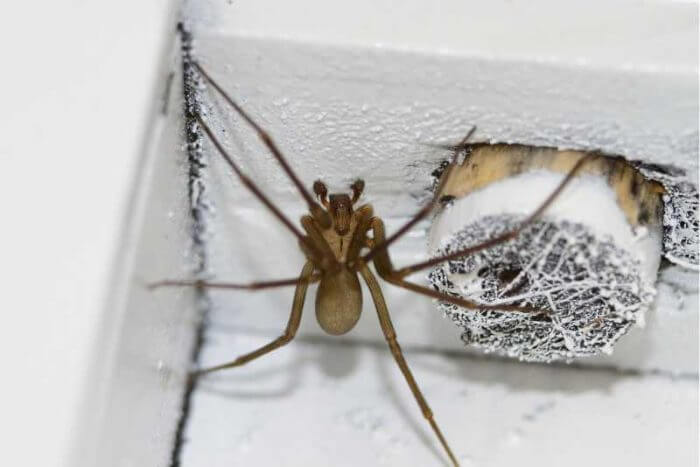
Their eyes are a key identifying feature, as they have six instead of the usual eight seen in many spiders, arranged in pairs in a semi-circular pattern.
Some Brown Recluse Spiders also sport a dark, violin-shaped marking on their cephalothorax, earning them the nickname “fiddleback” spiders.
While they’re not inherently aggressive creatures, Brown Recluse Spiders can bite when they feel threatened. However, this usually happens when a human unknowingly disturbs their nest, causing the spider to defend itself.
The venom of a Brown Recluse can cause localized reactions, including redness, swelling, and intense pain. In rare cases, the venom can lead to necrosis, a condition where the affected skin tissue dies.
However, it’s important to note that such severe reactions occur infrequently. If bitten by a Brown Recluse, it’s crucial to seek medical attention immediately to manage the symptoms and prevent complications.
Despite their venomous bite, encounters with these spiders are generally non-confrontational as they prefer to stay hidden, staying true to their ‘recluse’ name. They are an integral part of the ecosystem, helping control the population of pests like cockroaches and bedbugs.
Characteristics
- They have six eyes instead of eight
- Dark, violin-shaped markings on their cephalothorax
Habitat
- Seeks shelter in spaces like sheds or beneath fallen logs and rocks
- Prefers nesting in warm dry areas
7. American Nursery Web Spider
The American Nursery Web Spider, scientifically referred to as Pisaurina Mira, is a true spectacle in the world of arachnids, especially with its impressive size.
The females can grow up to 20mm in body length, and when you factor in their leg span, which often stretches over three inches, they easily stand among the largest spiders in Texas.
They’re often characterized by their body color, which ranges from shades of light brown to dark gray.
A distinct pattern adorns the top of their abdomen, often described as resembling a mask or face.
Their bodies tend to be elongated, and their legs are long and slender.
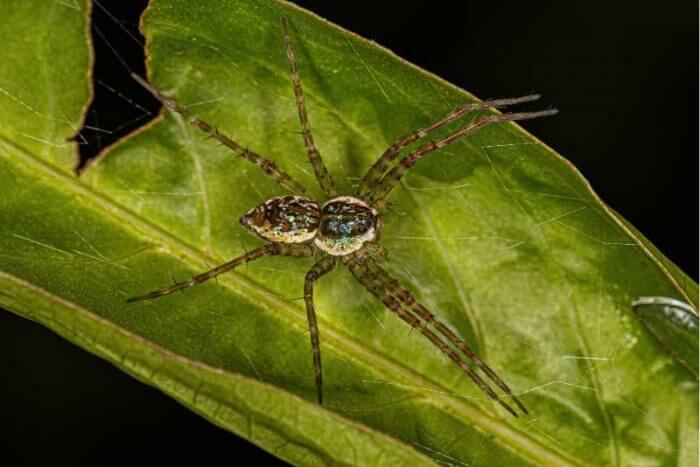
These spiders have a predilection for areas near bodies of water such as lakes, ponds, and streams. This is primarily due to the abundance of their favorite meals, small insects. They’re skilled hunters, and it’s not uncommon to witness them sprinting across the water surface in hot pursuit of prey.
One of the standout traits of the American Nursery Web Spider is the maternal instinct displayed by the females. As their name suggests, they construct ‘nursery webs’ for their egg sacs.
The female carries the sac in her jaws until the eggs are ready to hatch, at which point she builds a tent-like silk structure to safeguard her offspring. This protective behavior is quite remarkable and isn’t a characteristic shared by all spider species.
Characteristics
- Yellowish-brown in color with a light to dark brown band down the middle of the back
- White border around their abdomen
Habitat
- Can be found in grasslands and scrubs
- Likes sunbathing on brambles and stinging nettles
8. Drumming Sword Wolf Spider
The Gladicosa gulosa, more commonly known as the Drumming Sword Wolf Spider, is another spider that has made Texas its home. Notably, it’s the males of this species that have earned the ‘drumming’ moniker.
They create a percussive symphony by rhythmically tapping their abdomen and legs on various surfaces, producing sounds akin to drum beats.
In terms of size, Drumming Sword Wolf Spiders fall into the medium category, with females generally being larger than their male counterparts.
They can grow up to 19mm in body length. Their color palette ranges from brown to grayish-brown, complemented by dark bands adorning their legs and a chevron pattern on their abdomen.
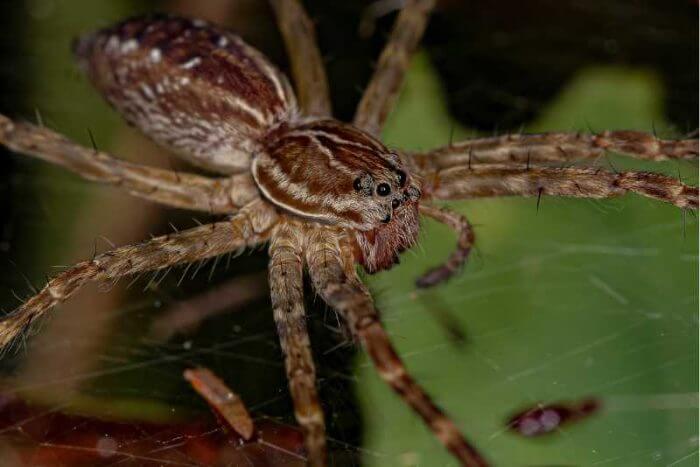
These spiders have a predilection for areas near bodies of water such as lakes, ponds, and streams. This is primarily due to the abundance of their favorite meals – small insects.
Skilled hunters, they often sprint across the water surface in hot pursuit of prey. One of the standout traits of the American Nursery Web Spider is the maternal instinct displayed by the females.
As their name suggests, they construct ‘nursery webs’ for their egg sacs. The female carries the sac in her jaws until the eggs are ready to hatch, at which point she builds a tent-like silk structure to safeguard her offspring.
This protective behavior is quite remarkable and isn’t a characteristic shared by all spider species.
Characteristics
- The females tend to carry their eggs in a spherical sac
- Has eight eyes arranged in three distinct rows
- The body is dark brown with their legs being slightly lighter in color
Habitat
- Can be found hiding under leaves during the day
- Typically nests in forests, or around plants and shrubs
What Is The Largest Spider Found In Texas?
Out of all the spiders in this list, we would have to say the largest spider in Texas would be the Brown Tarantula which can grow up to 4 inches long sometimes more.
Can These Large Spiders Be Found Outside Of Texas?
Absolutely, these large spiders are not exclusive to Texas! For instance, the American Nursery Web Spider can be found across the eastern United States and also in parts of Canada.
Meanwhile, the Drumming Sword Wolf Spider ranges across the eastern and central United States. Despite its name, the Texas Brown Tarantula is found in other southwestern states like Oklahoma, Louisiana, Arkansas, Kansas, Missouri, and even as far south as Mexico.
However, their distribution can depend on various factors such as habitat preference, climate, and availability of prey.
Are Any Of These Spiders Poisonous?
While many large spiders found in Texas and beyond are venomous, only a few pose a significant threat to humans. In fact, all the spiders mentioned above don’t really pose any dangers at all.
However, if by the off chance one were to bite you, the worst it would cause is a slight pain like a bee sting with some redness around the bite that’s all. Nothing a bit of soap and water couldn’t fix!
Conclusion
So there you have ultimate information about large spiders in Texas, if you made it to the end of this article then congratulations this was a lengthy post and we hope you enjoyed reading it.
Just don’t forget if you want to read more articles like this feel free to explore our site and see what other fascinating things you can learn.




Leave a Reply